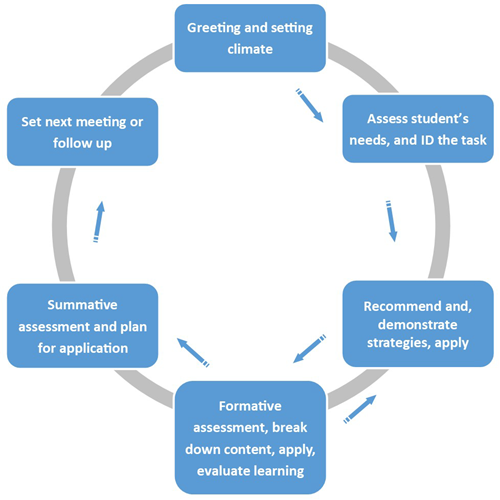Considering a tutoring approach for working with students during office hours
The Learning Commons at the University of Portland has made strides in professionalizing our  tutors through training. Our syllabus includes 11 hours of live face-to-face training modules. In our training, trainees learn how the tutoring cycle provides structure for our tutoring sessions. As a faculty member, I’ve also adapted the tutoring cycle as a strategy for helping students during office hours.
tutors through training. Our syllabus includes 11 hours of live face-to-face training modules. In our training, trainees learn how the tutoring cycle provides structure for our tutoring sessions. As a faculty member, I’ve also adapted the tutoring cycle as a strategy for helping students during office hours.
Six basic steps make up the tutoring cycle:
- Greeting and setting expectations: In the peer tutoring session, it’s important that the tutor let the student know that she or he can expect to work at the whiteboard or think aloud while working with material. We train our tutors to state their roles in a first session with a student and to remind students of their expectations in subsequent meetings.
- Assessing the student’s needs and identifying tasks: While a student may say, “I want to work on my homework,” it’s important for the tutor to identify more precisely what the student is struggling with and what their goals are for the course. The former can be done by asking more probing questions or even having the student show how they’ve approached a specific homework problem or prompt. Drafting with the student a specific agenda for the session by using a checklist on the whiteboard (or on paper) is a handy way of making the tasks visible.
- Recommending and demonstrating strategies: Our peer tutors usually have strategies that they can share with students. These can range from reviewing concepts or processes in their notes or the book to specific approaches or rules of thumb to use when working on a problem or task.
- Formative assessment: Having students practice problems or tasks and apply demonstrated strategies offers the tutor and student the opportunity assess progress. We train tutors to give implicit feedback through questions and other means of highlighting student thinking and misconceptions. Notice that from the diagram that tutors can shuttle back and forth between formative assessment (practice) and demonstrating strategies.
- Summative assessment and planning for learning: Every session needs to end with some sort of summative assessment. This can be a final problem or prompt, or the tutor may direct the student to teach the material on the agenda or checklist back to the tutor. When in a rush, the tutor can have the student list three takeaways, two ways he or she will use the takeaways, and one question about the material that the student wants to pursue in the coming week, also called a 3-2-1 assessment technique. The tutor also works with the student to sketch out a plan for learning for the next week.
- Setting up a follow-up meeting: If needed or desired, the tutor invites the student to set up another time to meet.
How might this work in an office hour interaction?
- Letting students know that they will be actively thinking and working when you ask the student questions and direct them to elaborate on something or work at a whiteboard (or on paper).
- Taking time to dig deeper into what the student knows and doesn’t know can help you and the student to plan the office hour visit. You can separate between what is needed and what might be nice to know and then focus on the needs. Asking questions and having the student do some work will reveal areas needing your attention.
- Once you know the students needs, you can share strategies for working with the material, ways of conceiving of it, or even methods for keeping track of learning (e.g., effective note-taking strategies that you’ve learned over the years).
- Allowing time for the student to practice with the material gives you time to assess her or his progress.
- A simple teach-back or 3-2-1 technique offers you a sense of how effective the office hour interaction was.
- The invitation to return or to ask questions in class can help the student to feel a sense of belonging and added motivation to participate in your class.
As you practice these steps, you will learn ways to vary them and apply them to groups during office hours. Faculty office hours needn’t be about students coming in to be retaught the material. We can instead apply tools like the tutoring cycle and other student engagement approaches to support active learning, metacognition, and higher order thinking.
Jeffrey White is an instructor of German and directs Learning Commons in Buckley Center 163. For more information on the Learning Commons’ certified tutor training program, contact Jeffrey at white@up.edu or (503) 943-7141.
The Learning Commons is a program of the Shepard Academic Resource Center and offers trained peer support in writing papers, math, foreign language learning, biology, chemistry, physics, managing group projects, speeches and presentations, along with hosting tutoring for several nursing courses and business courses.
